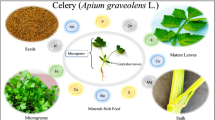Abstract
The foliage of 10 promising cultivars of vegetable amaranth from four cuttings were evaluated separately to gather information on different nutritional and antinutritional factors. Considering palatability and digestibility, the cultivars AV-35/1, AV-35, AV-45, AV- 77 and AV-63 were found to be the most promising because of low fiber and high protein (g/100 g). On an overall mean basis, the cultivar AV-35 (353.0 ± 54.6 mg/kg) followed by AV-45 (350.25± 73.59 mg/kg) and AV-35/1 (324.78±58.56 mg/kg) had the higher carotenoid contents. Leaf protein content ranged from 1.95 to 3.06 g/100 g with the maximum being in AV-63 (3.06 g). The ascorbic acid was variable (135.0 to 215 mg/100 g); the highest was noted in AV-64 (215.0 mg/100 g). Oxalic acid was lowest in AV-45 (0.06%) followed by AV-151 (0.11%). Considering overall nutritional values, AV-35, AV-45 and AV-35/1 were the promising genotypes.
Similar content being viewed by others
References
Prakash D, Pal M (1991) Nutritional and antinutritional composition of vegetable and grain amaranth leaves. J Sci Food Agric 57: 573–83.
Devadas RP, Saroja S (1980) Availability of iron and beta-carotene from amaranth to children. Proc Of the Second Amaranth Conference. Rodale Press, Emmaus. pp 15–21.
Kutsky RJ (1973) Ascorbic acid. In Handbook of Vitamins and Harmones. New York: Van Nostrand Reinhold Company, pp 71–78.
Prakash D, Joshi BD, Pal M (1995) Vitamin C in leaves and seed oil composition of the amaranth species. Int J Food Sci & Nutr 46: 47–51.
Shukla S, Singh SP (2000) Studies on genetic parameters in vegetable amaranths. J Gent & Breed 54: 133–135.
Katiyar RS, Shukla S, Rai S (2000) Varietal performance of grain amaranths on sodic soil. Proc Nat Acad Sci, India 70(B)II: 185–187.
Jensen A (1978) Chlorophylls and carotenoids. In Hellebust JA, Craigie JS (eds), Hand-book of Physiological Methods: Physiological and Biochemical Methods. Cambridge: Cambridge University Press, pp 5–70.
Watson CA (1994) Official and Standardized Methods of Analysis. IIIrd Edition, Pub-lished by The Royal Society of Chemistry, Thomas Graham House, Science Park, Cambridge CB4 4WF. pp 6.
Lowry OH, Rosebrough NJ, Farr AL, Randall RJ (1951) Protein measurement with the folin-phenol reagent. J Biol Chem 193: 265–75.
Glick D (1954) Methods of Biochemical Analysis. Vol 1, Interscience Publishers, Inc, New York. pp 127–132.
Bharadwaj K, Chandra V 1987 Trianthema portulacastrum Linn: Natural resource of oxalic acid. Res Ind 32: 112–23.
Panse VG, Sukhatme PV (1978) Statistical Methods for Agricultural Workers. ICAR, New Delhi.
Gupta K, Weigle DS (1988) Nutritional and antinutritional factors of green leafy vegetables. J Agric Food Chem 36: 472–474.
Author information
Authors and Affiliations
Rights and permissions
About this article
Cite this article
Shukla, S., Pandey, V., Pachauri, G. et al. Nutritional contents of different foliage cuttings of vegetable amaranth. Plant Foods Hum Nutr 58, 1–8 (2003). https://doi.org/10.1023/B:QUAL.0000040338.33755.b5
Issue Date:
DOI: https://doi.org/10.1023/B:QUAL.0000040338.33755.b5




